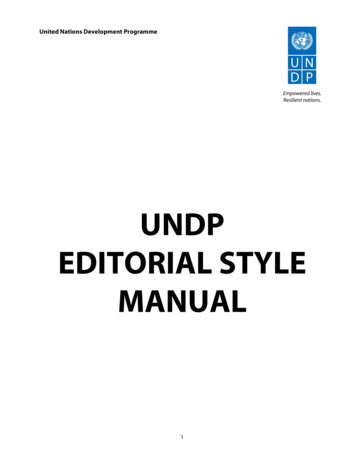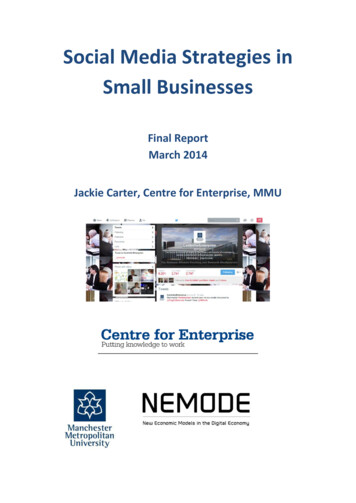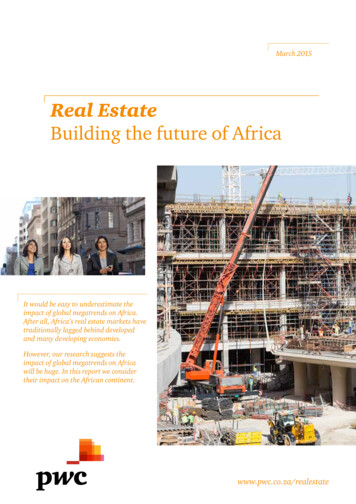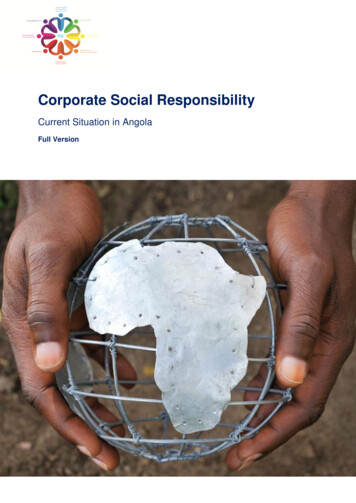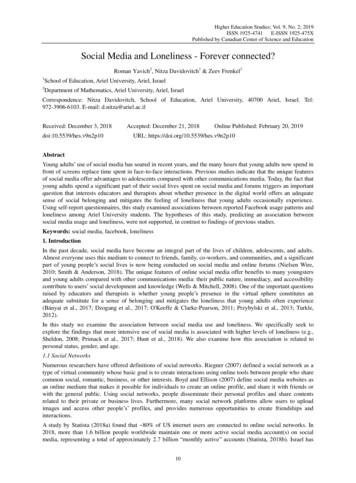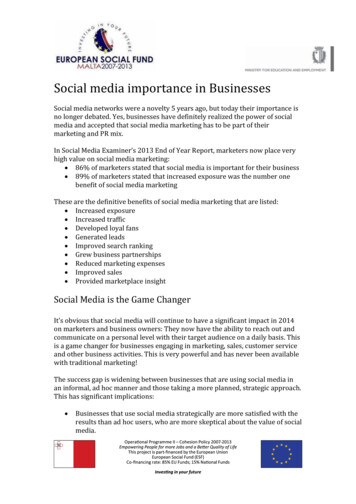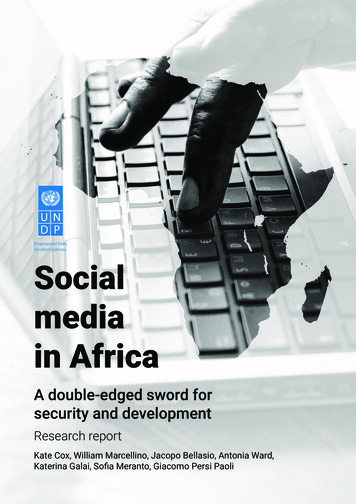
Transcription
Socialmediain AfricaA double-edged sword forsecurity and developmentResearch reportKate Cox, William Marcellino, Jacopo Bellasio, Antonia Ward,Katerina Galai, Sofia Meranto, Giacomo Persi Paoli
PrefaceThis is the final report of a study commissioned by the United Nations Development Programme(UNDP), which examines social media use and online radicalisation in Africa. With a focus on alShabaab, Boko Haram and the Islamic State in Iraq and the Levant (ISIL), the analysis also describesgovernmental efforts to address this problem in relation to these three groups and outlinesrecommendations for policy, programming and research.RAND Europe is an independent, not-for-profit policy research organisation that aims to improve policyand decision making in the public interest through research and analysis. RAND Europe’s clients includeEuropean governments, institutions, non-governmental organisations (NGOs) and other organisationswith a need for rigorous, independent, interdisciplinary analysis.For more information about RAND Europe or this study, please contact:Giacomo Persi PaoliResearch Leader, Defence, Security & InfrastructureWestbrook Centre, Milton RoadCambridge CB4 1YG, United KingdomTel. 44 (0) 1223 353 329 x2563gpersipa@rand.orgiii
Table of contentsPreface . iiiTable of contents. vList of figures . viiList of tables . viiiAcknowledgements . ixAbbreviations . xi1. Introduction . 11.1. Study context . 11.2. Purpose and scope . 21.3. Research approach . 31.4. Report structure . 52. ICT development in Africa . 72.1. Overview of ICT trends . 72.2. Social media as a force for good . 82.3. The dark side of social media. 93. Online radicalisation: a focus on al-Shabaab . 113.1. Al-Shabaab’s online strategy . 123.2. Engagement of social media users with al-Shabaab . 194. Online radicalisation: a focus on Boko Haram . 214.1. Boko Haram’s online strategy . 224.2. Engagement of social media users with Boko Haram . 275. Online radicalisation: a focus on ISIL . 295.1. ISIL’s online strategy . 305.2. Engagement of social media users with ISIL . 376. Social media narratives: the role of Twitter . 416.1. Overview of Twitter communities . 41v
6.2. Analysis of group-specific data subsets . 456.3. Key themes. 527. Strategies for countering online radicalisation . 557.1. Domestic government strategies . 557.2. UNDP programming . 617.3. Overseas government programmes . 628. Conclusion . 658.1. Summary of key findings . 658.2. Recommendations for policy, programming and research . 68References . 73vi
List of figuresFigure 1.1: Focus countries and terrorist groups . 3Figure 1.2: Structure of this report . 6Figure 2.1: Impacts of social media on security and development . 10Figure 3.1: Al-Shabaab’s main areas of operation in Africa . 11Figure 4.1: Boko Haram’s main areas of operation in Africa . 21Figure 5.1: ISIL's main areas of operation in Africa . 29vii
List of tablesTable 6.1: Overview of composition of top nine networks within ISIL community networks . 50Table 7.1: Domestic government strategies for countering al-Shabaab, Boko Haram and ISIL . 58viii
AcknowledgementsIn conducting this study, we are grateful to the many people who have provided their time, advice andsupport. Within UNDP, we would like to thank Yoshihiro Saito, Mohamed Yahya, Simon Ridley,Duhitha Wijeyratne, Chinpihoi Kipgen and Fauziya Abdi for contributing valuable feedback as the studyhas progressed.The research team is also grateful to the academic experts, policy experts, civil society representatives, localexperts and industry representatives who took part in research interviews. Their affiliations and, in somecases, their names are listed in Annex G of the Technical Annex: some interviewees’ identities have beenanonymised at their request.Within RAND, the team is appreciative of the valuable contributions of Zev Winkelman, MartinStepanek, Cord Thomas, Rouslan Karimov, Steve Davenport and Michael Ryan in support of the Twitteranalysis conducted as part of the study. Finally, the team is grateful to the quality assurance reviewersAlexandra Hall and James Black for their feedback.ix
AbbreviationsAHADIAgile Harmonised Assistance for Devolved InstitutionsAMISOMAfrican Union Mission in SomaliaAQCal-Qaeda CentralAQIMal-Qaeda in the Islamic MaghrebAUAfrican UnionCSOCivil Society OrganisationCVECountering Violent ExtremismEUEuropean UnionHSMPressHarakat Al-Shabaab Al Mujahideen Press OfficeICAIslamic Cultural AssociationICTInformation and Communications TechnologyISILIslamic State of Iraq and the LevantISISIslamic State in Iraq and SyriaISWAPIslamic State West Africa ProvinceIVRInteractive Voice ResponseK-YESKenya Youth Employment and Skills ProgramNACTESTNigerian National Counter-Terrorism StrategyNIWETUNiWajibu WetuNGONon-governmental organisationNSCVENational Strategy to Counter Violent ExtremismPAVEPartnering Against Violent ExtremismP/CVEPreventing and Countering Violent ExtremismPVEPreventing Violent ExtremismRQResearch QuestionSCOREStrengthening Community Resilience against Extremismxi
SMSShort Message ServiceSNCCTSudan National Commission for Counter-TerrorismSTRIVEStrengthening Resilience to Violent ExtremismUAVUnmanned Aerial VehicleUMSTUniversity of Medical Sciences and TechnologyUNDPUnited Nations Development ProgrammeUSAIDUnited States Agency for International Developmentxii
1. IntroductionUNDP commissioned RAND Europe to undertake a study exploring social media use and onlineradicalisation in Africa. This is the first publically available study to analyse how social media is used by alShabaab, Boko Haram and ISIL to contribute to radicalisation in seven African countries – Cameroon,Chad, Kenya, Nigeria, Somalia, Sudan and Uganda – by applying lexical and network analysis techniquesto primary Twitter data.1.1. Study contextThe role of information and communication technology (ICT) in Africa is a double-edged sword: while itcan promote social, political and economic development,1 it may also increase opportunities forradicalisation.2 Social media3 can equip terrorists with a low-cost tool to enlist, train, coordinate andcommunicate with followers and potential recruits remotely. Today, al-Shabaab, Boko Haram, ISIL andother violent extremist groups in Africa use Twitter, Facebook, YouTube and other social media channelsto broadcast their messages, inspire followers, and recruit new fighters to unprecedented levels.4There is an on-going debate over the role of online activities in the radicalisation process and in associatedcounter-radicalisation efforts.5 However, much of the recent discussion has focused on Western countriesin relation to ISIS’ online influence of homegrown terrorism and of foreign fighter6 travel to Iraq andSyria. Less is known about patterns of online radicalisation in Africa and about the extent to whichAfrican national governmental strategies address the use of social media by terrorist groups both insideand outside the region to support their strategic and tactical aims.To address this current gap in knowledge, UNDP commissioned RAND Europe to conduct a studyexploring social media use and online radicalisation in Africa. This is intended to support the UNDP1United Nations General Assembly (2013).There is no agreed definition of ‘radicalisation’. Existing definitions include ‘a process leading towards theincreased use of political violence’, ‘increased preparation for and commitment to intergroup conflict’, and ‘anescalation process leading to violence’ (Della Porta and LaFree, 2012).3In this report, ‘social media’ refers to websites, applications and other online communications channels that enableusers to create and share content or to participate in social networking. See Oxford Dictionary (2018).4Menkhaus (2014).5See, for example, the following RAND reports: Bodine-Baron et al. (2016) on ‘Examining ISIS Support andOpposition Networks on Twitter’ and von Behr et al. (2013) on ‘Radicalisation in the Digital Era’.26Foreign fighters refer to individuals that have, for a variety of reasons and with different ideological backgrounds,joined an armed conflict abroad (Boutin et al., 2016).1
Regional Centre for Africa’s Regional Project on Preventing and Responding to Violent Extremism inAfrica. This is an initiative that aims to better understand and respond to the effects of radicalisation andviolent extremism on the continent through evidence-based research and analysis.1.2. Purpose and scopeThis report aims at raising awareness of how social media is used by al-Shabaab, Boko Haram and ISIL aspart of their inventory of tools to radicalise individuals in Africa, and at outlining governmental efforts toaddress this issue in order to enhance future policy and programming in this area. While the mainemphasis of the study is on social media, the analysis also includes a focus on other communicationstechnologies or apps where data is available (e.g. WhatsApp) and on the use of radio, given its prevalencein the countries of focus.In support of these objectives, the following chapters address three research questions (RQ): RQ1: What trends can be observed in the use of social media in Africa to contribute to onlineradicalisation? RQ2: Have existing counter-radicalisation interventions by African national governments andnon-African government agencies: i.Focused on preventing and responding to online radicalisation?ii.Built innovative technological approaches into their design?RQ3: What implications can be drawn for the improvement of existing programmes and designof future programmes aimed at countering online radicalisation?These questions are analysed through the lens of three case studies focused on Islamist militant groups: alShabaab, Boko Haram and ISIL.7 These groups were selected for inclusion in the study on the basis that(i) they are based in Africa; (ii) they currently constitute three of the most lethal terrorist groupsworldwide;8 and (iii) they are known to make use of social media to further their strategic aims.9As Figure 1.1 illustrates, these groups have a presence in the seven African countries on which this reportfocuses. These countries include two that UNDP classifies as being at the epicentre of a security crisis(Nigeria and Somalia), four affected by spillover violence (Cameroon, Chad, Kenya and Uganda), andone described as being at risk of violent extremism taking hold (Sudan).10 Annex D of the accompanyingTechnical Annex provides an overview of the main security threats in relation to terrorism and politicalviolence affecting each of these countries.7While ISIL operates in many countries worldwide, the focus of this report is on its activities in relation to Nigeria,Somalia, Chad, Cameroon, Kenya, Uganda and Sudan only.8Institute for Economics & Peace (IEP) (2016); IEP (2015).9The aims, activities, tactics and targeting of each of these groups is described in more detail in Annex B of theTechnical Annex, while Chapters 3–5 describe their online strategies in more detail.10UNDP (2015).2
Social media in Africa: a double-edged sword for security and developmentFigure 1.1: Focus countries and terrorist groups11Regarding counter-radicalisation, the study focuses on existing strategies for preventing and counteringviolent extremism (P/CVE) developed by the national governments of Cameroon, Chad, Kenya, Nigeria,Somalia, Sudan and Uganda, as well as outlining relevant interventions coordinated by overseasgovernmental actors, with a particular focus on the United States Agency for International Development(USAID) given its active role in the region. In this part of the analysis, the research team examines theextent to which these strategies and programmes focus on countering online radicalisation, as well as howfar they build social media tools into their design and delivery. However, it was beyond the scope of thisstudy to explore interventions undertaken by technology companies or local civil society actors, and theintention was not to evaluate the effectiveness of the interventions examined.1.3. Research approachThis study is based on the application of three research methods: a structured literature review, keyinformant interviews, and Twitter data analysis. A summary of our research approach is presented below,with further details of the Twitter data analysis approach provided in Annex F of the Technical Annex.Literature reviewDrawing on peer-reviewed academic and ‘grey’ literature,12 the research team conducted a targeted reviewof literature focusing on the following thematic areas:11These classifications are applied by the UNDP through its regional classification system (UNDP, 2015).3
(1) The impacts of increased Internet access in Africa on development and security (informing theanalysis presented in Chapter 2).(2) The use of social media by al-Shabaab, Boko Haram and ISIL operatives and potential recruits in theseven focus countries (informing Chapters 3–5).(3) Government-led strategies in the area of countering online radicalisation in the seven focus countries(informing Chapter 7).This review was conducted through targeted Google and Google Scholar searches and ‘snowball’searching.13 Complementing our search of academic and grey literature in this domain, we conducted ananalysis of media reporting from 2012 to 2018.14 While we recognise that media articles may bepoliticised or fragmentary, media sources offer the most contemporaneous reporting and are important tobuilding a clearer picture of the three groups. Literature was included in the review on the basis ofrelevance to the research questions and the scope of the study, and findings were written up in a narrativesynthesis structured in relation to the three thematic areas outlined above.15Key informant interviewsA total of 14 semi-structured16 telephone interviews were conducted with five groups of stakeholdersidentified through RAND Europe’s contact networks. These included eight academic experts, two policyexperts, two civil society representatives, one local expert and one industry representative with knowledgerelating to the three terrorist groups and their activities in Cameron, Chad, Kenya, Nigeria, Somalia,Sudan and Uganda. The purpose of these key informant interviews was to validate the literature reviewfindings and to address any identifiable gaps in the available data. Interviews focused specifically on thelinks between social media use and online radicalisation, as well as on associated governmental responsesin the seven focus countries.An interview protocol was used to conduct these interviews,17 which lasted approximately one hour each.Interview findings were captured in transcripts structured around the questions outlined in Annex H ofthe Technical Annex.Twitter analysisWhile the secondary data collection focused on a wide range of technologies and platforms – includingTelegram, WhatsApp, YouTube, Facebook, Twitter, Kik and Ask.fm18 – the primary data collection12‘Grey literature’ is produced by organisations outside of academic or commercial publishing channels. Examples ofgrey literature include government documents, technical reports, working papers, doctoral theses and conferenceproceedings.13‘Snowball searching’ involves using a given document’s reference list to identify other relevant documents.14Date restrictions were not applied for the search of academic and grey literature to ensure that seminal works wereincluded in the review. The publication dates of the literature reviewed ranged from 1970 to 2017.15The research team reviewed English-language sources only when conducting the literature review.16Semi-structured interviews combine the use of an interview protocol containing specific questions with flexibilityto ask unplanned follow-up questions. By contrast, structured interviews follow an interview protocol with allinterviewees being asked exactly the same questions in the same order; while unstructured interviews consist of afree-flowing conversation on a given topic.17The interview protocol is presented in Annex H of the Technical Annex.4
Social media in Africa: a double-edged sword for security and developmentfocused on Twitter data only in order to explore how this particular social media platform is used todiscuss the activities of al-Shabaab, Boko Haram and ISIL.19 The aims of this approach were to identifythe types of online narratives associated with and cultivated by the three terrorist groups at the time ofselected major attacks or other high profile events (see Annex C of the Technical Annex).The Twitter data collection and analysis approach involved three steps:1.Designing and running targeted search queries aimed at scraping (i.e. gathering) relevantTwitter data and building a project Twitter dataset.2.Machine-based analysis of the project Twitter dataset through tools employing social networkand lexical analysis approaches.3.Research team analysis and interpretation of results and findings generated through machinebased tools.These three steps are explained in more detail in Annex F of the Technical Annex, along with anexpanded description of the Twitter search parameters.SynthesisTo address the first two research questions, findings from the literature review, interviews and Twitteranalysis were collated and consolidated during an internal workshop. Following this discussion, theresearch team wrote up findings as a narrative synthesis focusing on: (i) the use of social media by alShabaab, Boko Haram and ISIL; and (ii) counter-radicalisation interventions in the seven focus countriesand their overseas partners. In order to answer the final research question, these findings were then used asa basis for developing policy and programming recommendations for the governments of Cameroon,Chad, Kenya, Nigeria, Somalia, Sudan and Uganda. The final research question was also addressed byhighlighting the role that UNDP could adopt in supporting the uptake of these recommendations, as wellas by outlining areas for future research.1.4. Report structureAs Figure 1.2 shows, this report consists of eight substantive chapters covering: Chapter 1: An introduction to the study objectives and research methods. Chapter 2: A contextual outline of technology development in Africa. Chapters 3–5: An overview of the social media strategies of al-Shabaab, Boko Haram and ISIL. Chapter 6: An analysis of narratives created by Twitter users to discuss the three groups online. Chapter 7: An overview of African governmental strategies and selected overseas governmentalprogrammes in relation to countering online radicalisation.18These technology-based platforms and apps all allow users to create and share content and to communicate withother users. An overview of these platforms and apps is provided in Annex E of the accompanying Technical Annex.19Twitter was selected given that all three groups are known to have a presence on this platform and given RAND’sdata access and analytical capabilities in this area (see, for example, Bodine-Baron et al. 2016). See also Annex F ofthe Technical Annex for more details regarding the RAND Twitter Portal and RAND-Lex – a RAND-createdanalytical tool that can be applied to Twitter data analysis.5
Chapter 8: A summary of key study findings and recommendations for policy, programmingand research.This report is accompanied by a Technical Annex that acts as a repository of supporting information. Itcontains an introductory overview (Annex A) and background information in relation to the case studyterrorist groups and the countries examined (Annexes B–E), as well as methodological content on theTwitter data analysis and interviews conducted (Annexes F–H).Figure 1.2: Structure of this report6
2. ICT development in AfricaThis chapter provides a contextual overview of the spread of ICT and, more specifically, social mediaplatforms and services in Africa. It first outlines trends in relation to ICT access in Africa (Section 2.1),before outlining a number of developmental benefits of ICT across the continent (Section 2.2). Thechapter then explores why online radicalisation through the use of social media is an area of growingconcern. The following chapters examine how three groups with a presence in Africa – al-Shabaab, BokoHaram and ISIL – use social media to further their objectives (see Chapters 3-5).2.1. Overview of ICT trendsAn increasingly globalised economy has created opportunities for firms in developed countries to operateworldwide, including in emerging economies.20 Untapped markets in Africa are leading this trend as theyare becoming increasingly attractive to developers of new technologies. ICT is an area that has benefitedfrom such investment and market progression, while also supporting the expansion of some of Africa’sfastest growing economies in countries such as Kenya, Ghana and Nigeria.21 Internet bandwidthavailability for Africa's one billion citizens has grown twenty-fold between 2008 and 2012,22 and 46 percent of the overall population in Africa had subscribed to mobile services by the end of 2015.23According to the World Bank and African Development Bank, innovations in ICT are transforming localbusinesses, driving entrepreneurship and promoting economic growth in Africa.24 Technology hubs acrossthe continent – including iHub and Nailab in Kenya, Hive Colab and AppLab in Uganda, ActivSpaces inCameroon, BantaLabs in Senegal, and Kinu in Tanzania – are creating new spaces for collaboration,innovation, training, software and content development.25 Used by businesses and governments in Africancountries, these new technology hubs are also helping drive progress in the agricultural and financialsectors, as well as bringing improvements in relation to climate change, education and healthcare policy.2620Oke et al. (2014).Oke et al. (2014).22World Bank (2012).2123George et al. (2016). For more detailed Internet user statistics in relation to Cameroon, Chad, Kenya, Nigeria,Somalia, Sudan and Uganda, see Table D.0.1 in Annex D of the accompanying Technical Annex.24World Bank (2012).25World Bank (2012).World Bank (2012).267
Experts agree that the technological breakthrough with the greatest impact on the continent relates to thesharp rise in mobile phone use.27 Africa is the world’s fastest growing mobile phone market, with thenumber of subscribers rising from 10 million to 647 million between 2000 and 2011.28 Demand formobile phones continues to grow in Africa, particularly given the affordability of mobile services.29 Themobile phone market reportedly has a higher growth impact on per capita income in Africa relative to theother communication technologies, such as fixed telephone main lines.30In Africa, mobile phones are said to be used for maintaining networks of family and friends,31 for mobilebanking, for comparing market prices, for collecting health data, for advertising and for finding jobs.32Moreover, the spread of mobile phones has enabled the rapid growth of social media use on thecontinent.33 However, the growth of social media in Africa has proven to be a double-edged sword. Whileit has supported economic development and encouraged political engagement,34 social media has also ledto a number of less desirable impacts; for example, by equipping terrorist groups with a readily accessibletool with which to propagate their message and recruit followers.2.2. Social media as a force for goodThe growing use of Facebook, Twitter, African news apps and other forms of social media in Africa hasincreased citizens’ awareness of political events, changing perceptions both nationally and internationallyand giving ‘less celebrated actors’ a voice in global and local discourse.35 For example, increasing Twitteruse in Kenya is said to be linked to citizens’ interest in challenging misrepresentation by the internationalmedia in terms of how violence and election campaigns are reported.36 Similarly, in Nigeria, social mediaactivity has reportedly been encouraged as a result of the Nigerian mainstream press’s reluctance to reportsensitive issues, or critique the conduct of Nigerian government officials or powerful corporations.37In particular, Twitter is a form of social media that has revolutionised political discourse38 and enabledAfrican populations to communicate in new ways. Unlike other platforms, Twitter is easily accessiblethrough a mobile phone and can give ordinary citizens a voice in international online discourse.39 Modesof Twitter use include critiquing controversial development projects such as the #1millionshirtscampaign,40 and creating ‘hashtag’ movements such as #RhodesMustFall,41 and #FeesMustFall.42 A high27See: Baro & Endouware (2013); Chavula (2013).Carmody (2013).29Baro & Endouware (2013); RAND Europe interview with civil society representative, 17 November 2017.30Chavula (2013).31Baro & Endouware (2013).32Chavula (2013).33As of 2013, for example, there are several thousand Kenyans on Twitter (Nyabola, 2017).34Green (2014).35Kassam et al. (2013); Jacobs (2017).36Nyabola (2017).37Jacobs (2017).38Ruge (2013).2839Nyabola (2017).40#1millionshirts refers to a charity campaign dedicated to sending 1,000,000 shirts to African countries (Twitter,2017a).8
Social media in Africa: a double-edged sword for security and developmentproportion of tweeting in Kenya has been done through the use of images in order to dismiss unfoundedclaims from the international media and to adjust global perceptions of Kenya and its citizens.43 Kenyanshave also resorted to Twitter when propagating messages in relation to the presidential election campaignsin 2013.44Social media
African national governmental strategies address the use of social media by terrorist groups both inside and outside the region to support their strategic and tactical aims. To address this current gap in knowledge, UNDP commissioned RAND Europe to conduct a study exploring socia


